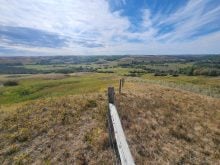Chickpea farmers no longer have to peer over their shoulder when treating their seeds with Crown.
As of April 30 it is legal to apply the seed treatment to chickpeas to help prevent ascochyta blight.
It’s a development that was heralded by the manufacturer, the pulse industry and government officials.
But in reality it won’t put a huge dent in the ascochyta problem because many chickpea farmers have been using the product illegally for years.
Crown is produced by Gustafson and is readily available at most chemical retailers, seed cleaners and elevator companies across the Prairies.
Read Also

Pakistan reopens its doors to Canadian canola
Pakistan reopens its doors to Canadian canola after a three-year hiatus.
It was originally registered as a disease control for lentils in 1994, but the Pest Management Regulatory Agency has expanded the label this year to include ascochyta blight control in chickpeas.
“This label expansion is great news for farmers growing chickpeas,” said Garth Patterson, executive director of the Saskatche-wan Pulse Growers.
“The seed treatment Crown has the ability to reduce (ascochyta) infection levels 10-fold on the planting seed.”
The Gustafson News release
news states that growers will face fewer problems with the fungal disease in their chickpeas this season.
But several sources including pulse processors, Saskatchewan Crop Insurance officials and Saskatchewan Agriculture staff, said growers have been treating their chickpea seed with Crown for years, even though the chemical was registered only for lentils.
“I’ve certainly heard people talk about using it – yeah, definitely,” said Saskatchewan Agriculture special crops specialist Ray McVicar, who was instrumental in gaining the temporary registration.
“Sometimes we are a little bit behind getting things registered before they are used and unfortunately that’s the way it is.”
Bill Maksymetz, Saskatchewan regional manager for the PMRA, said he only recently heard that chickpea producers were illegally applying the product.
“We don’t have any complaints that I’m aware of in past years of potential misuse,” said Maksymetz.
“It seems like there has been some allegations recently.”
He said the PMRA doesn’t have the resources to police every crop and every chemical. The maximum fine is $50,000 for using a product on a crop for which it isn’t registered.
Despite the controversy surrounding the previous illegal use, McVicar said registration is a big deal for farmers.
“It doesn’t mean you can completely eliminate seed-borne ascochyta in chickpeas, but it does mean you can reduce it by 80 to 85 percent.”
Data from Saskatchewan Crop Insurance shows there were 617 disease-related claims last year in the province that is home to virtually the entire Canadian chickpea crop.
Farmers were paid $12.2 million for claims on 126,827 acres, which represents about 18 percent of the 700,000 acres of chickpeas seeded in 2000. Not all of the disease-related claims were due to ascochyta, but it is the most devastating disease in chickpeas.
Gustafson said farmers should be treating all their chickpea seed with Crown in conjunction with Apron FL, another seed treatment for controlling pythium.















